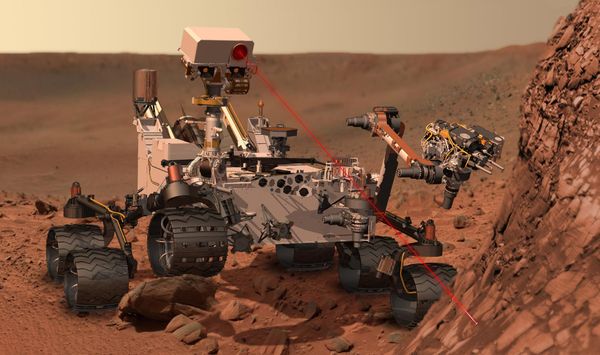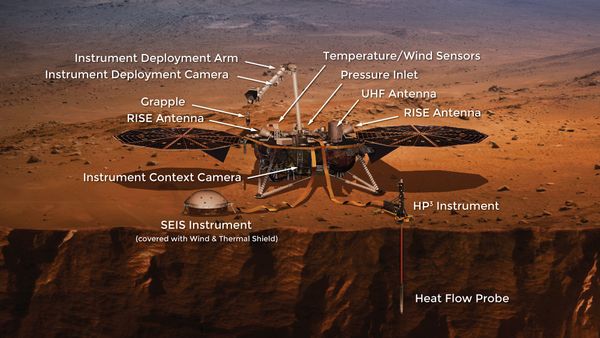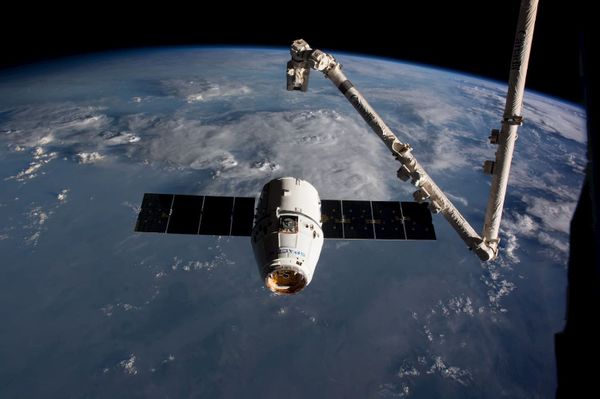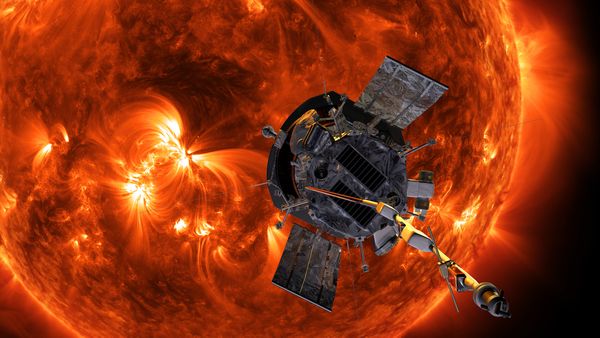Whether it be NASA directives, FCC regulations or military operations in space, there's no doubt that policy has a significant impact on industry at every turn Today on SPEXcast we will take a closer look at space policy with Marcia Smith, the founder and editor of SpacePolicyOnline.com.

In addition to her space journalism, Ms. Smith is president of the Space and Technology Policy Group specializing in policy analysis of civil, military and commercial space programs. Prior to this, she earned thirty-one years of experience providing objective, nonpartisan analysis at the Congressional Research Service, followed by three years at the National Research Council as the director of the Space Studies Board and the director of the Aeronautics and Space Engineering Board, Marcia has also authored or co-authored more than two hundred and twenty reports and articles on space, nuclear energy and telecommunications, not including her articles and reports on SpacePolicyOnline.
Phil Linden: Marcia, welcome to SPEXcast.
Marcia Smith: Thank you very much for inviting me.
T.J. Tarazevits: What do you mean when we talk about space policy?
Marcia Smith: Policy is the overarching principles that one has in order to conduct one's business or whatever it is you want to do. So there are business policies and government policies. Its a very broad term in the context of national space policy. It's usually something that is set by the president and/or by Congress.
T.J. Tarazevits: Can you describe your beat as a space policy journalists?
Marcia Smith: I cover all space activities, domestic and international, commercial, civil, military. I cover the whole range of space activities, and I do it from a policy perspective, not from an engineering perspective or science perspective. But, of course, the policy makers in Washington want to know what's going on in science and technology. It's the whole beat. I cover everything.
T.J. Tarazevits: When we speak about space policy, we're not talking about a NASA regulation for how to torque a specific bolt, right? What is space policy in a broad sense? Can name some examples?
Marcia Smith: strategy in order to carry it out. But the policy can be American leadership in space. Policy can be that we're going to work with international partners or we're gonna work with commercial partners. All of those are policy decisions that are made for the overall principle of what it is we want to accomplish with space program.
T.J. Tarazevits: What is the role of organizations like the Congressional Research Service and the National College of Sciences when it comes to forming new policies and deciding on which programs to pursue?
Marcia Smith: So there is policy that is made at the White House through directives. Right now, President Trump has put out four Space Policy Directives that set out what his administration's policy is, and some of them build upon the National Space Policy that was put out by President Obama. Congress has policies that they do through laws. There are many NASA authorization laws that is the policy for the Civil Space program. There are defense authorization laws that set policy for the National Security space program. Some of those say that this is how we're going to interact with the commercial sector. So that's where all the policy comes in and there are many players in setting policy. I mean more than you probably can imagine and their lobbyists who come in representing companies or organizations. There are individual constituents who have some interest in space, and they contact the policymakers in Washington. Then there are these organizations, think tanks, and some of them take points of view and others don't that are sort of a residence of expertise that will come in with studies that say, "You should do this, that or the other". So all of these things are impacting policy. The Congressional Research Service is a department of the Library of Congress, but unlike the rest of the library, it works exclusively for the members of the committees of Congress, and it's basically a think tank for Congress but it does not take positions on issues. Its entire job is to inform the debate; to provide objective, non partisan analysis to help members of Congress understand what the choices are. What are the pros and the cons? What's going to happen if you go this way? What's going to happen if you go that way? So the members of Congress can make better informed decisions when they're setting policy.

Vice President Pence announced plans to return humans to the Moon by 2024. However, Congressional support will be the key factor in whether that plan proceeds.
CRS works only for the legislative branch, and it helps them in setting policy. The National Academy of Sciences, Engineering and Medicine, which most people just called the National Academies, is outside the government. It is a nonprofit organization. It was actually created in law in 1863 by President Lincoln, and it gathers together science and engineering experts from around the country and sometimes from other countries in order to provide expert advice mostly to the federal government. They do some work for other organisations, but mostly to the federal government. They're coming at it with a different set of people. People who are working in these areas, the top scientists, the top engineers, bringing that expertise into the policymaking process so that people can make better informed decisions. But they do take positions on issues.
Phil Linden: With your work at the Congressional Research Service and the National Academy of Sciences, I'm sure that when you were performing these studies, you probably had an expectation for what the outcome would be. Was there ever a case where the policy result did not match what you expected at the start?
Marcia Smith: Actually, when you're doing these studies or where you're working at CRS, you have no idea what the result is going to be, especially in the political realm, because there are so many factors that feed into politics, and so you can look at a particular issue like, should you build a space station or not? And some of that has to do with money. A lot of these policy decisions depend on funding, and so it often comes down to just how much money is available to do these things. But it's also politics, and which member of Congress holds a powerful committee position and may or may not have somebody from a NASA Center or a DoD center in their district. So there are all these factors that feed into policy. I tell people who want to get into policy that the most important attribute you have to have is a good sense of humor because you can work on these issues day in, day out, sixteen hour days, seven days a week, and you really think you're making progress and people are understanding why this position is better than that position. And maybe sometimes you even get it through. Maybe a directive comes out, or Law comes out that yes, they understood. And then a whole bunch of new politicians get elected and they say, "Well, I don't like that", and then they change it and you're back to square one. I can't think of a case, actually, where I expected any particular outcome in these studies. Our jobs, whether it's CRS or at the Academy, is to provide the best analysis or the best advice that we can provide and what the policy makers do with it, they do with it.
T.J. Tarazevits: Fascinating. You were the director of the Space Studies Board and the Aeronautics and Space Engineering Board. Those two organizations sound pretty similar. What's the actual difference?
Marcia Smith: Well, this Space Studies Board primarily does space science as opposed to engineering. These the boards are sort of an administrative unit through which the academy's do their work, grouping things into different categories. Back in the day, the National Academy of Sciences had a space studies board and the National Academy of Engineering had the Aeronautical Space Engineering Board. But there were a number of reed organizations over the decades, and now they're both within the same division of the academies, and they used to be completely separate. They had separate board directors and separate sources of funding, and they were totally separate. There actually was a third Board for many years, but the three combined into two, and then the two aren't really combined yet. One really has an engineering focus, and one has a science focus. But they do now have a shared director. I was the first person to be director of both boards, but since I left, the next two directors also have directed both boards, and the Aeronautics board does a lot of aviation work in addition to space so that they really are different organizations, but interelated.
Phil Linden: On that note, policy often takes longer to develop than the technologies that it effect. Is this a benefit or a weakness to the policymaking process?
Marcia Smith: Well, I think that in many fields, maybe not so much in space, but certainly some of the information technology things like the Internet, policy does often lag technology. And by the time you get a law passed or directive approved by a President, that technology has marched on. But policy by its nature, generally speaking, is much bigger and broader than a specific technology. So while it does hamper you in the case, say you're trying to protect privacy on the Internet. It's very hard for laws to catch up with that because it takes so long for laws to get passed. But for something like space, we're still debating all these decades later whether to go back to the moon before you go to Mars, and so you don't quite see that so much in the space realm. But you do see it in other technology areas.
Many space, ground and sea systems work to provide ballistic missile defense for the United States. Source: DoD
T.J. Tarazevits: Switching gears here to policy, mil-space and the future space operations. The military, with very large budget, has a lot of impact in what we do in space. The household name of space policies is the Outer Space Treaty. What is the future of the Outer Space Treaty? India just tested a new anti-satellite missile technology in March, and as more countries are pushing its boundaries or straight up crossing them what will its role continue to be?
Marcia Smith: Treaties are laws. It's the highest law of the land, according to the Constitution. So the Outer Space Treaty is a law, not so much a policy but an actual law, and it does not prohibit anti-satellite tests. So the fact that India or China or the United States or the Soviet Union conduct anti-satellite tests does not violate the Outer Space Treaty and doesn't require any changes to it. The Outer Space Treaty bans military activities on the moon, but not on Earth or in Earth orbit. It does prohibit placing weapons of mass destruction in Earth orbit, but the anti-satellite weapons that have been tested so far are not weapons of mass destruction. There's been debate for the last two to three decades about whether or not the Outer Space Treaty has outlived its usefulness. Overall because of the basic principles that it has and the fact that there are over one hundred countries that have signed on to it, I think there's a general feeling that it is worthwhile to keep the treaty as it is, to keep it in force, to not walk away from it and not try to change it. Because if you try to change it, then you opened up Pandora's box and you don't know what's going to happen. There have been discussions for years and years with the United Nations about additional treaties, particularly on banning weapons from outer space. But they have not gone anywhere. And I think in the current climate, getting new treaties, probably on just about anything, let alone on space, is probably unlikely. But I think the Outer Space Treaty still serves a very useful purpose at setting out the basic principles of exploring and using space.
T.J. Tarazevits: The US Strategic Space Command has made statements that space is now a contested domain. How do geopolitics affect our national space policy?
Marcia Smith: Oh, geopolitics have a very dramatic impact on space policy, I think both in the civil and the national security sphere. One area that people point to where geopolitics has not had an impact, is the International Space Station, where the United States and Russia are still cooperating very effectively on that, despite the changed geopolitical climate since they annexed Crimea, back in 2014.. But yes, geopolitics has a dramatic impact on space across the board.
T.J. Tarazevits: One of the biggest newsworthy new space policies of 2018 was the announcement of a potential Space Force and discussions around that. What role do you think the Space Force will play in policy creation if it becomes a real government agency? For example, we have a lot of organizations of different sizes and varying influence both in the public and behind closed doors. For example, the NRO, Air Force Strategic Command, NASA, and the FAA. With a much larger organization like Space Force in play, how do they participate together in creating policies?
Marcia Smith: Right now, the way the Space Force is conceived, it will be part of the Air Force, and it's not going to be all that large comparatively speaking. They're talking about maybe fifteen to twenty thousand people in the Space Force. The purpose of the Space Force is not really to set policy. It's to organize, train and equip. That's the phrase they use for what the military services do. The Space Force's job will be to organize, train and equip personnel to support the U. S. Space Command, which they are reestablishing. So it's not just the Space Force and they are not going to be people in space stations in space doing things. They're going to be no sitting in offices like all the other service members do, and their job will be not setting policy. There are people in the Air Force and people in the DoD who advise on policy and set policy, but their job is to organize, train and equip the personnel to support U. S Space Command and its role in prosecuting any activities that we need in order to protect and defend our space assets.
Phil Linden: That said, do you think the existence of the Space Force and serving this role to organize, train and equip personnel will exert any pressure on the existing ecosystem of participants vying for funds in the government sphere?.
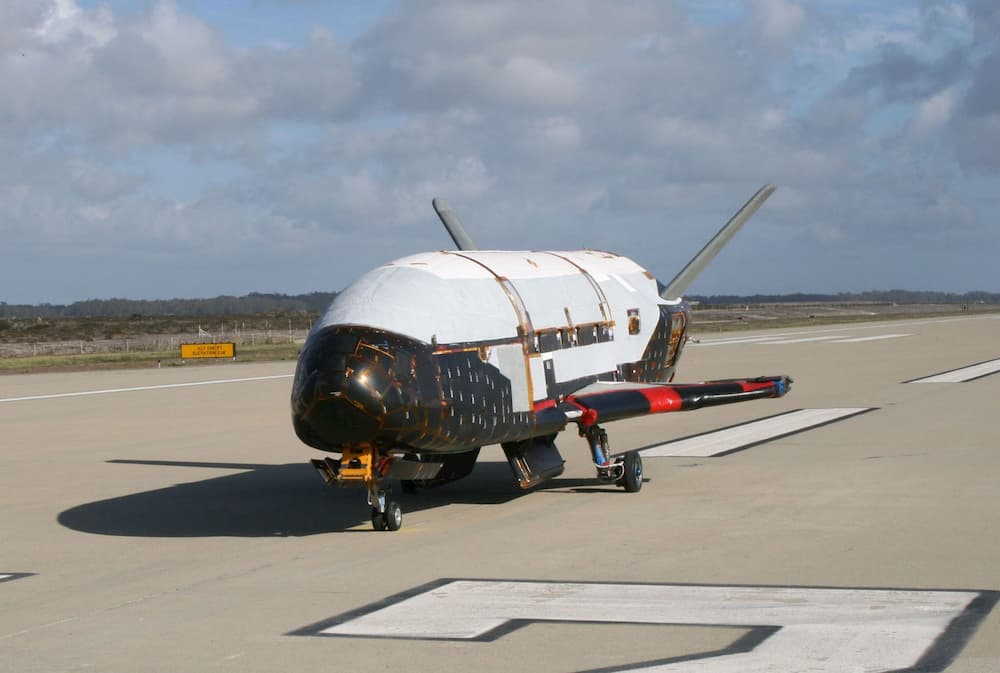
The X-37b spaceplane is one of the many military funded space programs in the U.S.
Marcia Smith: One of the reasons that people are advocating for a Space Force is because, as it is now, sort of integrated into the rest of the Air Force, they feel it's not getting sufficient attention and sufficient funding. The hope is that if you pull it out it into it being a separate entity, that, yes, it will get additional funds that it needs in order to ensure that we have the space assets that we need and that they are defendable. Yes, I think that there will be more money going into the space aspects of this. I don't think it's going to be a tremendous increase. What they're asking for right now is about $14 billion for the unclassified space program. The funding figures for the classified space program are classified, so we don't really know how much those folks are spending. But the unclassified “white programs” are going to be about $14 billion dollars in DoD spending. About $13.8 billion of that's in the Air Force. That is an increase over last year. I think that there will be more money going into the national security space sphere, in part because there has been such a drum beat over the past two years about space becoming another war fighting domain because it really was not thought of in that context. Previously, it waw thought of as a sanctuary. That it was something that was really so remote that what you would need in order to make an effective attack on the space assets was beyond the capabilities of most of our adversaries. But now that especially Russia and China are ramping up their anti satellite programs, there's a feeling that the systems are much more vulnerable and that space is a war fighting domain, just like land, sea and air and cyber.

The International Space Station went through many revisions before settling on the current outpost in Low-Earth Orbit.
Phil Linden: Switching gears to civil space, NASA directives are subject to the goals of White House administrations, but mission timelines often exceed a single term. The recent 2024 goal of returning humans to the Moon is led by the White House and Vice President Pence. How does the White House and Congress work on long term initiatives like these across congressional sessions and administrators?
Marcia Smith: Well, that's the $64 billion question, or probably even more than that. It's been part of the challenge for these long term goals, like returning to the moon and going on to Mars because they do exceed presidential terms and Congress changes every two years. It's difficult to keep the momentum going from administration to administration. We've seen these big changes as new administrations come in. But it's not impossible.The space station is a perfect example of that. The space station began in Ronald Reagan's presidency, and it survived the change to George H. W. Bush to Clinton, to George W. Bush to Obama to Trump. So that is a program, a long term program that has been able to survive, and part of it is because it's been able to change itself. The space station that was started by Ronald Reagan in 1984 is really quite different from the space station that we have today, both physically in terms of what is comprised off and in terms of the international partnerships, because Russia was brought in after the Soviet Union collapsed during the Clinton administration, so they were brought in as a partner. So if you look at the illustrations of the space station, the very early ones, like from 1984-1986, they are completely different. There is a dual keel space station with all these different elements to it, and because of funding constraints, that got knocked down physically. When you look at the object that we have today, and even in 1993, when they reconfigured the space station because of cost overruns., the actual object that we have up there now is pretty similar, but some of the modules are smaller, and we never did build some of the modules, especially one that the scientists wanted which was a very large centrifuge facility.
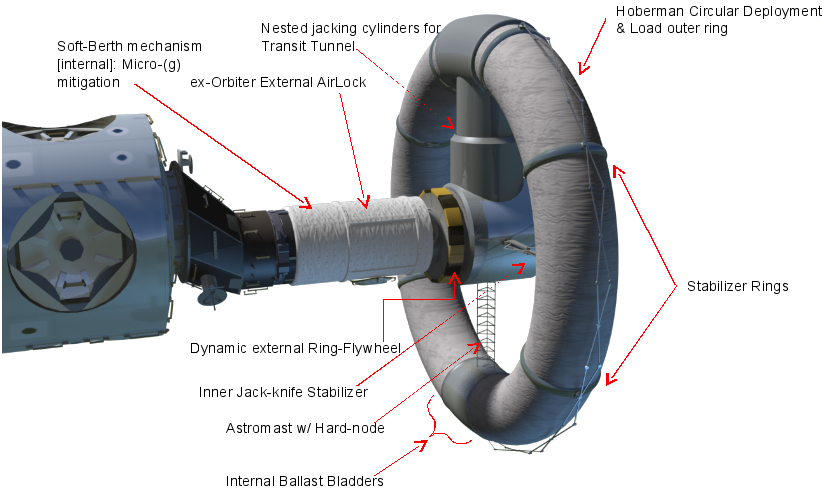
A centrifuge module was one of the many science modules canceled from the finalized ISS design
But it has been able to change with the times, and the international partners have added strength to the program. They have stuck with the program through all these decades and all the changes, because the United States seems to change its mind a lot, and the partners have to come along with us, and it's a marriage that has stayed together, amazingly, through all these decades, and it looks like it's going to stick together for probably another decade or so. It is possible to have programs that stay together through administrations by changing and adapting as need be. Starting this whole new program to return humans to the moon and go on to Mars has been a problem since we last walked on the moon in 1972. It was George H. W. Bush who really started the effort in 1989, and his effort failed, the Space Exploration Initiative, and that was primarily due to money. And then his son, George W. Bush, started the Constellation program and that failed again because of money, because it was going to cost much more than the Obama administration was willing to spend. So they changed it, and we weren't going to go back to the moon, not to the surface and instead we were going to do the asteroid redirect mission and that never really caught on. And then finally you get President Trump coming in and he's saying, “Well, no, we want to go back to the lunar surface”, so you keep the you keep changing the goalposts all the time. And Bill Gerstenmaier, the head of human exploration and operations at NASA, I think has done a really good job coming up with a program that can be flexible. And so we'll see. Probably in the next few days we’ll see what the new budget request is from NASA to fulfill Vice President Pence's goal of getting back to the moon by 2024. But we’ll see whether or not it survives this time.
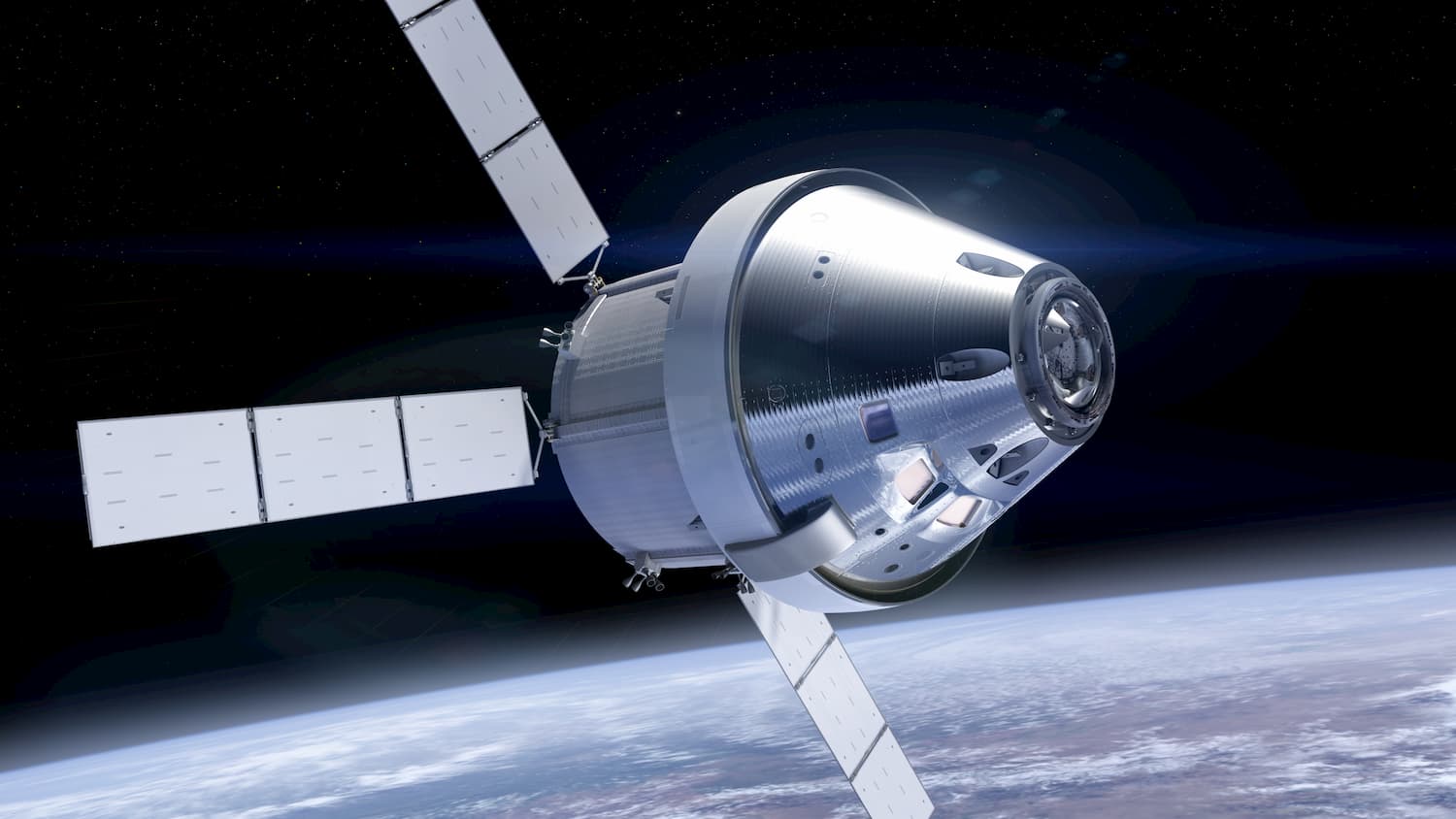
The Orion capsule remains the lynchpin vehicle in NASA-led crewed missions beyond Low Earth Orbit
Phil Linden: SLS and its predecessor Constellation, provide really good foil to the example you gave with ISS because it's difficult to change the hardware, in the direction it's going but what they've been able to do is, as the goalposts change, they've been able to adapt what missions SLS will conduct. As far as the development of SLS now, What are the things that are driving the SLS development in particular. What are the primary policy factors? Is it mostly money? Is it political support?
Marcia Smith: The SLS has a very interesting history, actually, because the Constellation program was not going to use that vehicle. They had the Ares and it was going to build Ares I and Ares V, a very different design. They were killed by the Obama administration. The Obama administration did not want a big rocket. Their plan was to invest in game changing technologies so that before you chose a rocket design, you might want to build something entirely different. Maybe you'd have other kinds of propulsion than chemical propulsion? They did not want to build a big new rocket at all. That was their plan. But Congress was very unhappy with that and it was Congress that directed NASA to build the Space Launch System. Typically in law, you don't get into a lot of technical details. You tell an agency, go build a rocket, but you don't say it has to launch 130 metric tons. But in this particular case, because Congress felt so strongly about it, especially the Senate. People joke that it's the Senate Launch System and not the Space Launch System. They spelled out what the requirements were for this base launch system, and that is what NASA is aiming for. They have three versions of it, and the final version will be the 130 metric ton version that's required by law. NASA is marching towards that. They've been working on a SLS since 2011.
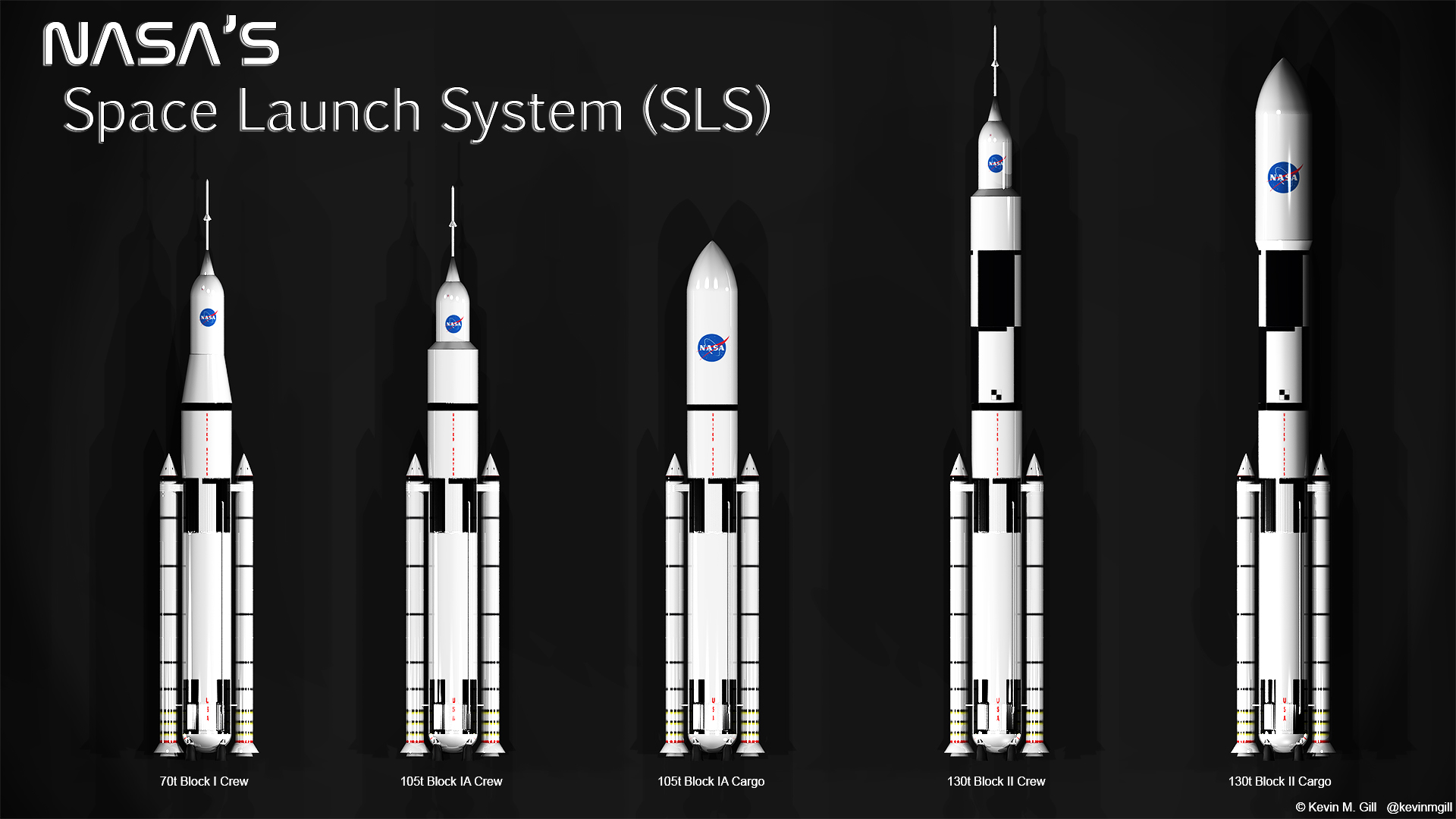
Several versions of SLS are planned. Credit Kevin Gill
The directive from Congress 2010, so they were working on SLS since 2011. And, of course, the schedule keeps slipping. That's part of what has spawned this sudden announcement that we're gonna try and get back to the moon by 2024. It's the antithesis of what was going on. So the date was slipping, the date was slipping. Boeing came to NASA in March and said its going to slip again into 2021 and the White House, instead of accepting another delay, came back and said, “No, we're going to get to the surface of the moon by 2024”, which is four years earlier than NASA was planning, and Pence didn't say Boeing, but he said, “you know if the current contractor can't do it. Then we’ll find a contractor that can. And if NASA can't do it, then we're going to have to change NASA.” Those were very bold statements, and we're just going to have to see how that works out because there's only so much you can do to accelerate the schedule. NASA is looking at that now. Some people in NASA were thinking of skipping some of the tests and the Aerospace Safety Advisory Panel (ASAP) came up and very strongly said, “Don't skip this green run test” and Congress hasn't even been presented with the budget for doing this. Everybody was taken off guard by this announcement by the Vice President. We have no idea whether or not Congress is going to adopt this, because this is one of those policy decisions that does require funding. Congress under the Constitution has the power of the purse, and so they're going to have to come up with a budget that Congress can agree with, and I think that's going to be a very challenging task to actually be able to get all this done. It's not just SLS that you need. You need a rocket. You need a spacecraft, you need a vehicle to get down the back and you need spacesuits. Presumably they're going to get out of the lander once they land on the surface. And I don't really hear people talking about spacesuits. So it's going to be a lot of money in just five years.
For the full interview, check out the episode on iTunes or your podcast service of choice.





